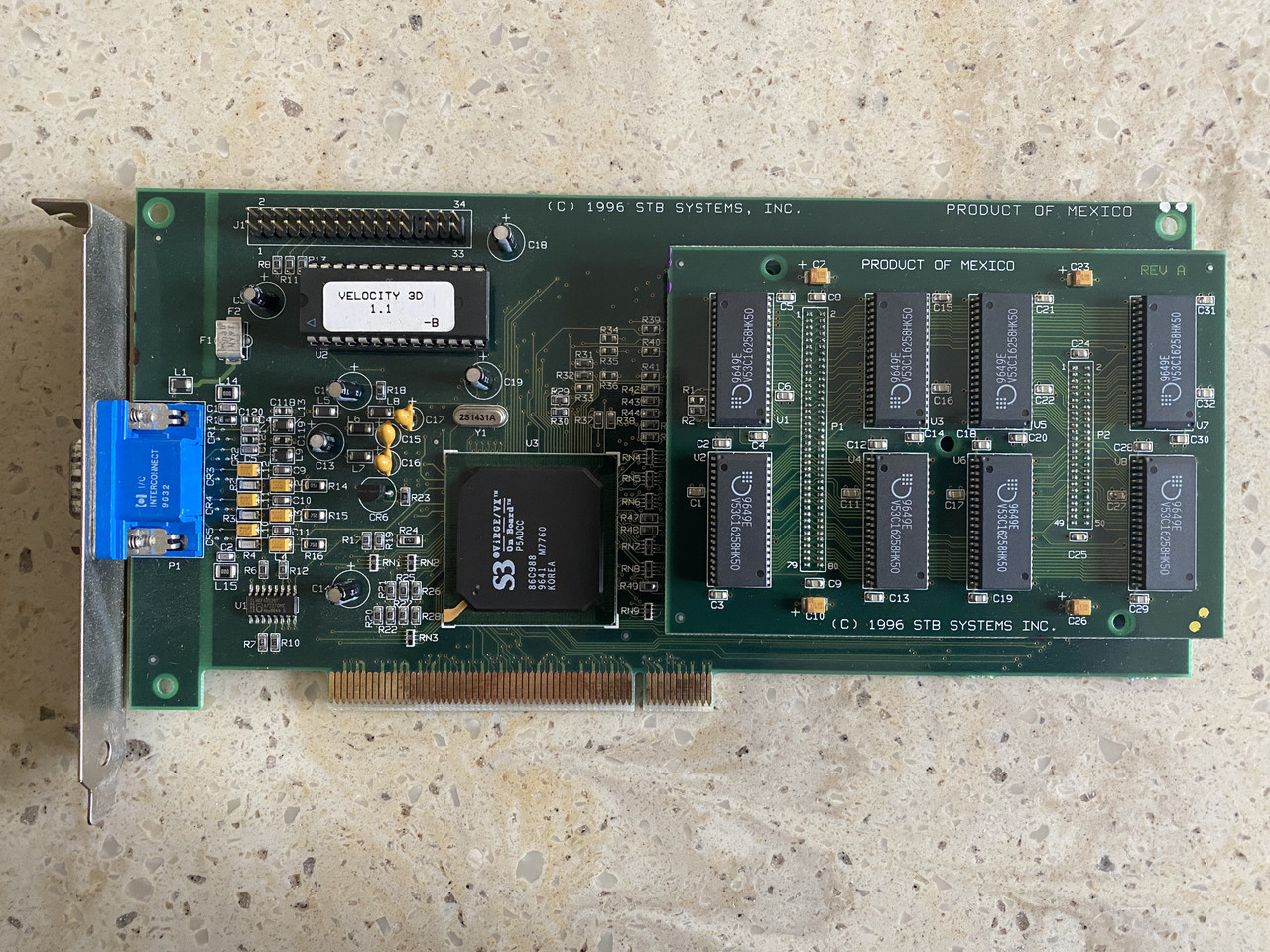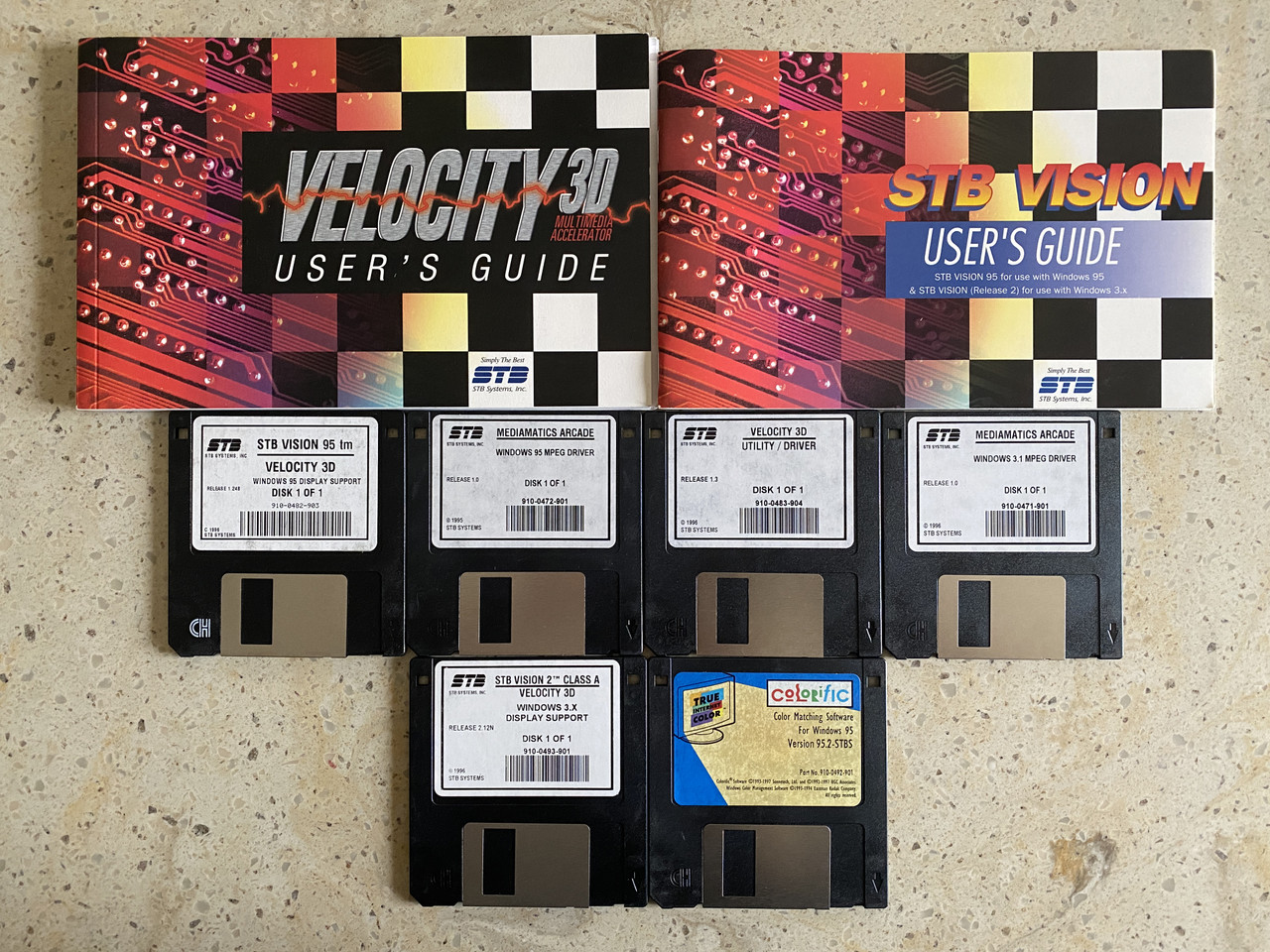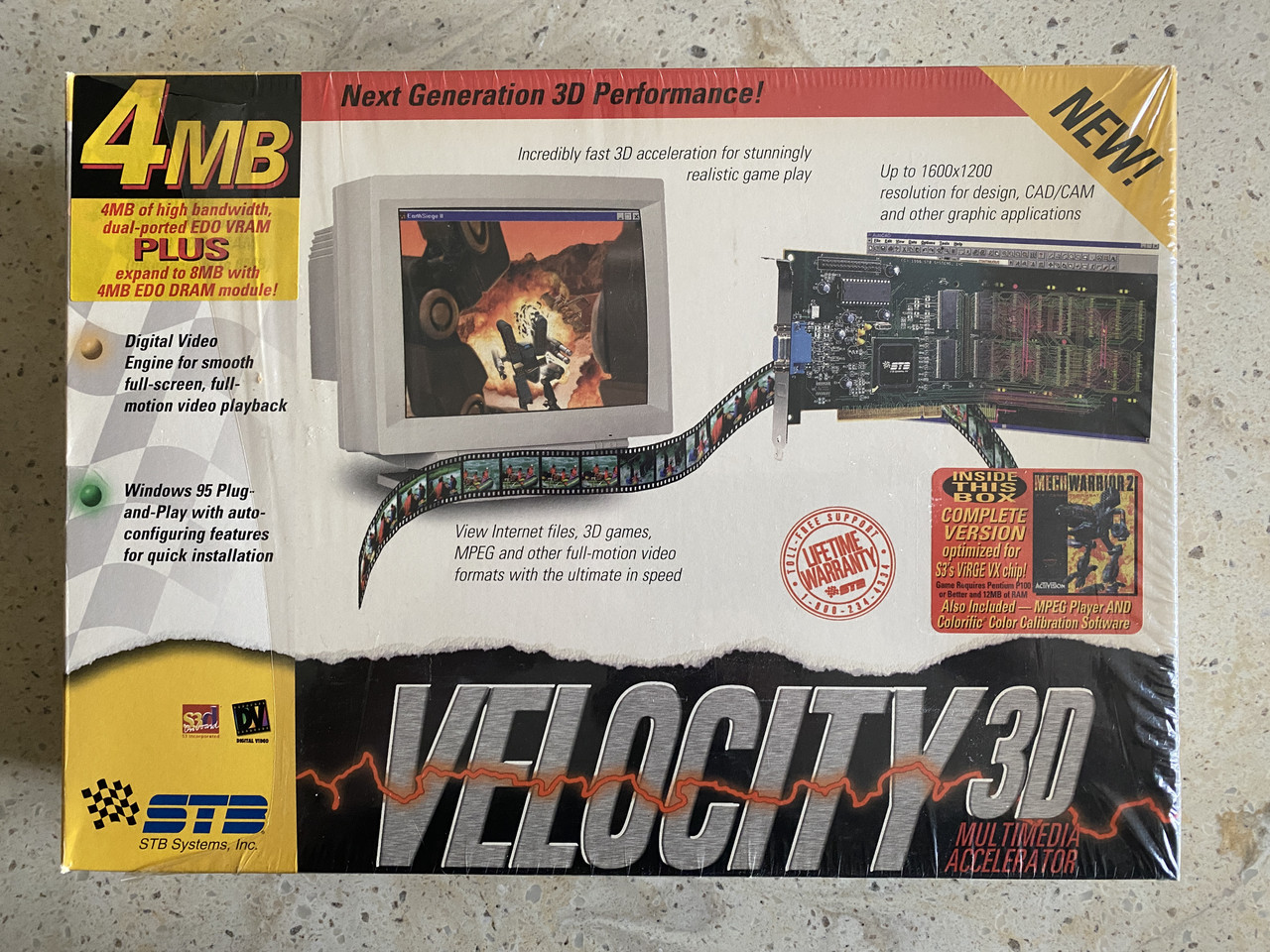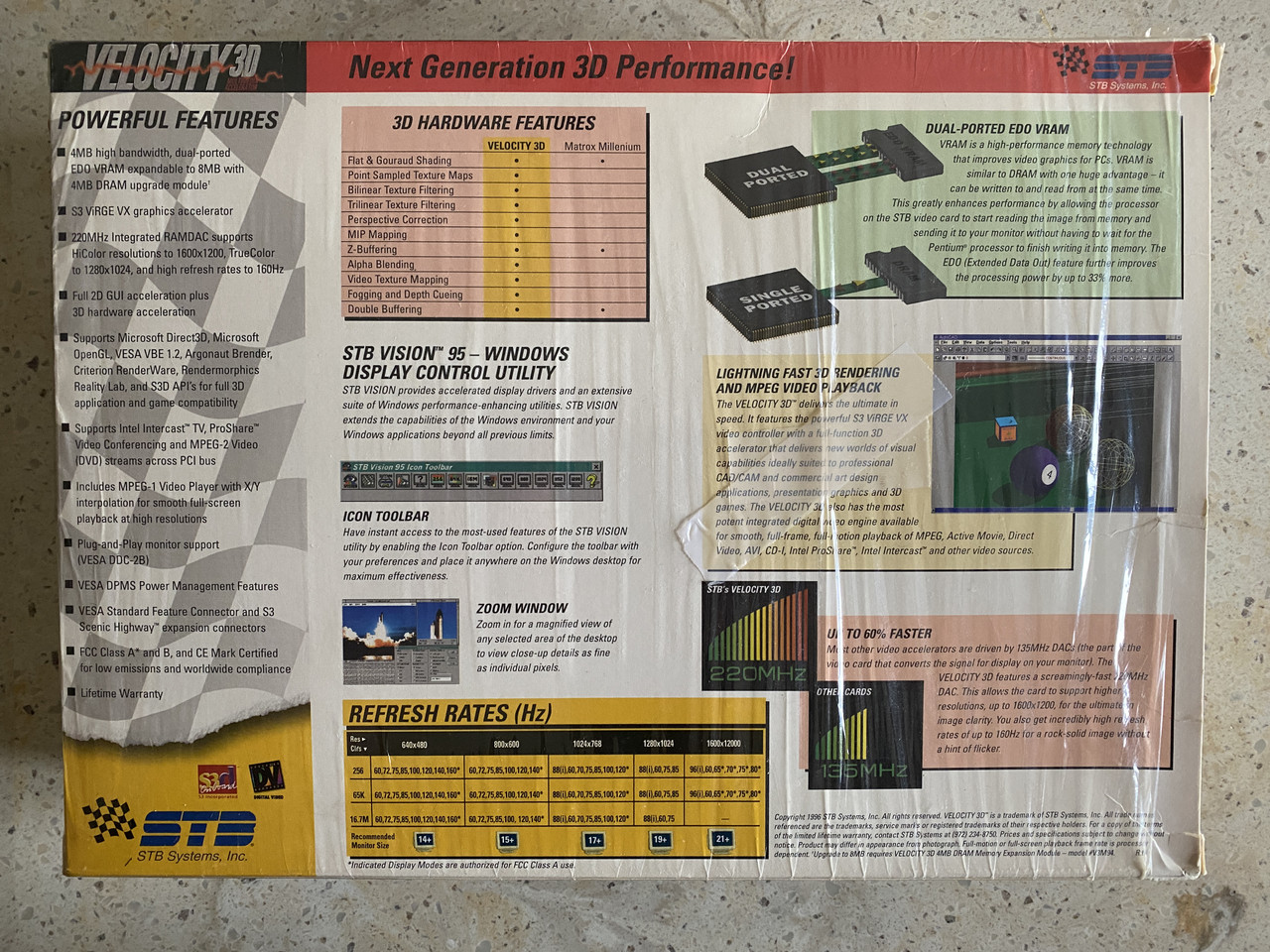STB Velocity 3D
The Velocity 3D was STB Systems' card based around the S3 ViRGE/VX chipset. The card in the pic below has the optional 4 MB DRAM memory upgrade installed.
 |
Released | September 1996 |
| Bus | PCI | |
| Chipset | S3 ViRGE/VX | |
| Standards | Hercules, CGA, EGA, VGA | |
| Memory | 4 MB of EDO VRAM (expandable to 8 MB) | |
| RAMDAC | 220 MHz | |
| Ports | 15-pin DSUB (analogue video out) | |
| Part # | 1X0-0444-305 | |
| FCC ID | - | |
| Price | At launch: $449 | |
| See Also | Velocity 64V |
STB Systems said on the Velocity 3D: "VRAM is a high-performance memory technology that improves video graphics for PCs. VRAM is similar to DRAM with one huge advantage it can be written to and read from at the same time. This greatly enhances performance by allowing the processor on the STB video card to start reading the image from memory and sending it to your monitor without having to wait for the Pentium® processor to finish writing it into memory. The EDO (Extended Data Out) feature further improves the processing power by up to 33% more.
The Velocity 3D delivers the ultimate in speed. It features the powerful S3 ViRGE VX video controller with a full-function 3D accelerator that delivers new worlds of visual capabilities ideally suited to professional CAD/CAM and commercial art design applications, presentation graphics and 3D games. The Velocity 3D also has the most potent integrated digital video engine available for smooth, full-frame, full-motion playback of MPEG, Active Movie, Direct Video, AVI, CD-I, Intel ProShare, Intel Intercast and other video sources.
Most other video accelerators are driven by 135MHz DACs (the part of the video card that converts the signal for display on your monitor). The Velocity 3D features a screamingly-fast 220MHz DAC. This allows the card to support higher resolutions, up to 1600x1200, for the ultimate in image clarity. You also get incredibly high refresh rates of up to 160Hz for a rock-solid image without a hint of flicker."
The card's features included:
- Full 2D GUI acceleration plus 3D hardware acceleration
- Supports Microsoft Direct3D, Microsoft OpenGL, VESA VBE 1.2, Argonaut BRender, Criterion RenderWare, Rendermorphics Reality Lab, and S3D API's for full 3D application and game compatibility
- Supports Intel Intercast TV, ProShare Video Conferencing and MPEG-2 Video (DVD) streams across PCI bus
- Includes MPEG-1 Video Player with X/Y interpolation for smooth full-screen playback at high resolutions
- VESA DDC-2B support for Plug-and-Play monitors
- VESA DPMS Power Management features
- VESA Standard Feature Connector and S3 Scenic Highway expansion connectors
On the 3D front it had hardware support aplenty, including flat & gouraud shading, point-sampled texture maps, bilinear and trilinear texture filtering, perspective correction, MIP mapping, z-buffering, alpha blending, video texture mapping, fogging and depth-cueing, and double-buffering.
From November 1996, the Velocity 3D came bundled with a version of Activision's popular MechWarrior 2 combat simulation game optimized for the S3 ViRGE series of video controllers, Colorific monitor/printer color matching program, and the Mediamatics MPEG Arcade Player.
Refresh Rates:
| Res/ Colours |
640x480 | 800x600 | 1024x768 | 1280x1024 | 1600x1200 |
| 256 | 60,72,75,85, 100,120,140,160 | 60,72,75,85, 100,120,140 | 88i,60,70,75, 85,100,120 | 88i,60,75,85 | 96i,60,65, 70, 75,80 |
| 65K | 60,72,75,85, 100,120,140,160 |
60,72,75,85, 100,120,140 | 88i,60,70,75, 85,100,120 | 88i,60,75,85 | 96i,60,65, 70, 75,80 |
| 16.7M | 60,72,75,85, 100,120,140,160 |
60,72,75,85, 100,120,140 | 88i,60,70,75, 85,100,120 | 88i,60,75 | - |
| Bold modes are authorized for FCC Class A use. | |||||
Board Revisions
I don't have any information on board revisions for the Velocity 3D cards.
Competition
As mentioned, the Velocity 64V was their implementation of S3's Vision968 chipset, which it shared with other cards this year, including the Number Nine Motion 771, Diamond Stealth 64 Video VRAM, ELSA Winner 2000 Pro/X, Genoa VideoBlitz III AV, and Hercules Graphite Terminator Pro.
3D was becoming the new battleground, and S3 were a step ahead, launching the replacement to their Vision series with the ViRGE in 1995 - featuring direct hardware support for bilinear and trilinear texture filtering, MIP mapping, alpha blending, video texture mapping, Z-buffering and other 3D texture mapping. In competition, we had ATI with the Rage 3D chipset.
Video acceleration was also something buyers were seeking, with a combination of Windows 95, faster CPUs and more memory, video playback on your desktop was now a reality. Chipsets aiming to provide this in 1995 included ATI Mach64, Matrox MGA2064W. I.C. Works ZoomDAC, S3 Vision 968, Western Digital WD9710, Videologic PowerPlay 64 and Tseng Labs VIPeR f/x.
In the February 4 1997 issue of PC Magazine, the Gateway P55C-200FPC featuring the Velocity 3D was awarded the PC Magazine Editors' Choice Award in a review of the industry's first Intel Pentium-based systems to feature MMX technology. Despite facing formidable competition from Diamond's Stealth 3D 2000 and Matrox Millennium accelerators, the Velocity 3D's performance put it in a class of its own. PC Magazine called the test results, which were recorded using Ziff Davis' Graphics Winmark 97 test suite, "stunning". According to the magazine's editorial review, "Powered by an STB Velocity 3D graphics engine, the system posted an astronomical score that put it 51 percent ahead of the nearest home PC competitor."
In the February issue of PC World, the Velocity 3D earned the PC World Best Buy Award and was ranked number one in the monthly Top 10 Graphics Boards review. This was the second consecutive time an STB video card had debuted at number one on the PC World Top 10 Graphics Board list, after STB's LightSpeed 128 earned that distinction in August of 1996.
In the Media
"
STB® Velocity 3D Redefines 3D Accelerator Market
Aggressive Pricing Strategy and No-Compromise Performance Makes Velocity 3D the Leader in 3D Video Accelerator Category
Richardson, Texas-(September 17, 1996)-STB Systems, Inc.®, (NASDAQ-STBI) made waves throughout the graphics card industry today when it announced the Velocity 3D Windows and Multimedia Accelerator with an extremely aggressive price. Along with category leading performance, STB is introducing the new graphics adapter with hardware 3D for $249 with 4MB of memory and $349 with 8MB.
"Only a year ago the highest performing video cards where limited to workstation applications, an area of the market where high prices are accepted. A 4MB product recently cost over $500 and an 8MB card was around $1000." said J. Shane Long, Vice President of Sales and Marketing. "The recent declines in memory prices coupled with our continually increasing volume allows us to introduce the Velocity 3D, a card with workstation like performance, at less than half that price."
The Velocity 3D features 2D/3D hardware acceleration, accelerated full-motion video playback, and support for Microsoft® Direct X API. It is offered with 4MB of EDO VRAM and has an optional daughter card that supplies an additional 4MB of DRAM for a total of 8MB. The VELOCITY 3D delivers up to 16.7 million colors for photo-realistic images and ultra-high resolutions to 1600x1200 with refresh rates up to 160Hz.
Preliminary testing has the Velocity 3D performing at previously unprecedented speeds in benchmark tests, as well as 2D and 3D applications. This is a result, in part, of the combination of a 64-bit 2D acceleration engine, a high performance 3D rendering accelerator and a high performance Digital Video Engine delivered by the S3r ViRGE VX graphics controller ASIC employed by the Velocity 3D.
Accelerated 3D, 2D and full-motion video
The new graphic adapter's hardware 3D capabilities deliver extremely realistic perspectives by combining Gouraud shading, perspective-correction, bilinear filtered MIP-MAP texture mapping, Z-buffer support and double-buffering technologies. The result is immersive 3D gaming worlds, extreme detail in 3D modeling or presentation programs and breathtaking graphics in other 3D applications.
The Velocity 3D's 64-bit 2D acceleration engine excels where previous hardware 3D cards had failed. The 2D performance surpasses the best marks set by previous generation products. The Digital Video Engine provides bilinear interpolated playback that can be viewed in an icon size window or scaled up to full screen. In addition to supporting Microsoft ActiveMovie, the Velocity 3D is designed to work with upcoming multimedia related products from STB that will support DVD/MPEG 2 and Intel Intercast streams.
The VELOCITY 3D is being incorporated as a manufacturer's standard graphic accelerator in many of the world's most popular Intel Pentium and Pentium Pro-based personal computers. This new STB accelerator will be released for sale in September of 1996, and will be available at leading computer retail outlets nationwide. The Velocity 3D comes with a limited lifetime warranty."
STB Systems Press Office, 17th September 1996
Setting it Up
I have no information on setting up the Velocity 3D.
Downloads
For Windows 98, the Vision95 software will not work. Use the embedded STB Systems/STB Velocity 3D (S3 ViRGE-VX 988) display drivers or the S3/S3 ViRGE-VX PCI (988) display drivers.
Operation Manual Get in touch if you can provide this missing item! |
Original Utility Disk Velocity 3D Utility/Driver release 1.3 |
ROM BIOS Get in touch if you can provide this missing item! |
Windows 3.1 Drivers Velocity 3D Class A Windows 3.x drivers |
Windows 95 Drivers Velocity 3D Certified Windows 95 drivers Vision 95 release 1.52A |
Windows NT 3.51 Drivers Velocity 3D Windows NT 3.51 drivers |
Windows NT 4.0 Drivers Velocity 3D Windows NT 4.0 drivers |
More Pictures




Images shown for this card are courtesy of Vogons member, Artex
